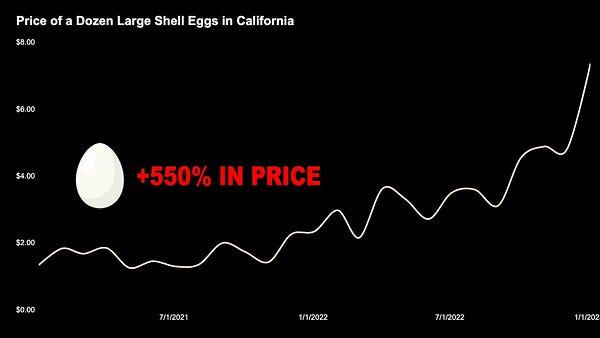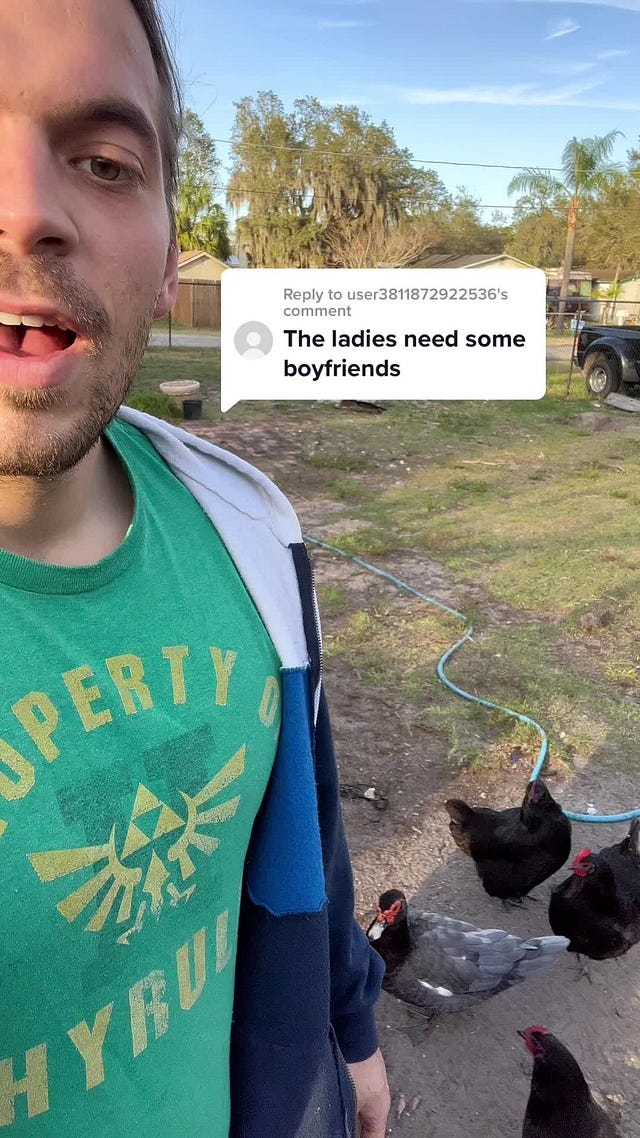How to Survive the Looming Egg Famine
Industrialized food production is failing fast. In response, we need a full-fledged a Chicken Coup.
At first, I figured it was a fluke. Around Christmas, my local Trader Joe’s ran out of eggs. No worries, I thought – a lot of people probably decided to make egg nog at the same time.
But then it happened again, a few weeks later. Costco’s walk-in refrigerator was out of eggs. Then, it wasn’t just eggs, but Kerrygold grass-fed butter too.
For me, this wasn’t just a garden-variety inconvenience. The possibility of recurring butter and egg shortages is an existential threat to my vitality.
During the pandemic, people got used to empty shelves at the grocery store. Remember the meat shortages when the big packing plants got hit hard early on? Now, we hardly bat an eye when two of the biggest staples are routinely unavailable.


Meanwhile, where eggs are available, they are up to five times more expensive. California is getting hit particularly hard. Yet despite higher prices, people are not eating fewer eggs. Essential food items like eggs have what’s called a low “elasticity of demand.” Unlike, say, brand-name clothing, which can be substituted for cheaper options if the price rises, egg “substitutes” like pumpkin puree and I can’t believe it’s not Egg!™ aren’t fooling anybody.
In other words, there’s no way out of this shortage except through.
What’s causing the shortage?
The main reason for the shortages seems to be an Avian flu outbreak that began in February of last year. Since then, domestic egg supply has decreased by about 7.5 percent on average each month. Thankfully, there are signs that the flu is abating, but the situation on the shelves will get worse before it gets better.
We might heed this as a warning sign that something is wrong upstream of the shortage. Cramped tenement homes were the primary breeding grounds for infectious diseases. COVID likewise exacerbated certain unhealthy living conditions. Aside from the elderly, its main victims were the obese and vitamin D deficient (i.e., those cooped up indoors). With Avian flu, it’s the caged birds who never see the sun that are getting hit hardest by bird flu.
Most of the 60 million birds that have died so far have been in large, centralized egg factories. Some farms have had to slaughter whole swaths of birds when just one is found to be infected.
You may have noticed that pasture-raised eggs can still be found on some shelves where the cheaper eggs are gone. Although smaller-scale decentralized egg production might not be as efficient, it is more resilient. Not long ago, even Walmart pledged to buy only cage-free eggs, but the general increase in inflation and supply chain issues have forced them to renege on their promise.
Some have blamed Bill Gates for allegedly buying up a majority of farmland and forcing a plant-based agenda on the population. I looked into this because it sounded sinister. It turns out that the Gates Fund actually only owns about 1/4,000 of the farmland in the United States (242,000 acres), and Gates himself has praised small-scale chicken farming as a solution for world hunger (Why I Would Raise Chickens, Gates Notes, 6/7/16).
I once wrote a ‘Poor Man’s Paleo’ guide to thriving on $10/day (or less), which talked about how chickens are like little machines for efficiently turning plant and insect protein into high-quality animal protein. In other words, you don’t need to “eat ze bugs” per Klaus Schwab’s Great Reset conspiracy – ze chickens will do it for you. Chickens also have a tiny carbon footprint compared with other animals, which is a good proxy for being low-cost even if you’re not worried about carbon.
Which Way, Mother Hen? Practical and Legislative Solutions
While Gates’s focus is on the developing world, I say we need a suburban revolution of backyard chicken farmers right here in the United States. How can we foster such a movement?
For starters, California should declare a state of emergency. In response to the housing crisis, the state recently passed a zoning exemption that lets property owners build an in-law unit or subdivide the parcel without getting the city’s permission. We could do the same thing with respect to local ordinances preventing people from owning backyard chickens.
At the national level, Congress can amend and finally pass Thomas Massie’s long-overdue PRIME Act. The bill would exempt meat producers from burdensome federal USDA requirements when selling their products within state lines. Though originally intended to make the beef supply more resilient, it could easily be extended to poultry and egg producers. Most states have their own food inspectors whose standards are at least as strict as the USDA. Progressive states like California could pioneer new standards that prevent public health threats like the Avian flu and other maladies of over-industrialization.
However, we shouldn’t wait for the government to do something about egg shortages. We can work within existing ordinances to maximize our own backyard egg yields. Chicken coops and feed aren’t expensive, and they don’t make too much noise as long as you don’t get a rooster. As TikTok celebrity Urban Chicken Farmer notes, roosters are superfluous anyway.
 Tiktok failed to load.
Tiktok failed to load.Enable 3rd party cookies or use another browser
Pullets, or egg-laying full-grown hens, are fairly cheap. Chicks are practically free if you have the patience to build a DIY “brooder.”
Finally, we can vote with our dollars and purchase the highest-quality eggs we can afford. Even at $6/dozen, pasture-raised eggs are a nutritional powerhouse worth every penny. Buying them sends a signal to the grocery store and farmers to invest in more holistic production.
From a practical standpoint, you should avoid grocery shopping on Sunday nights or Monday mornings, since most stores restock overnight during the week.
If you want more tips on getting the most bang for your buck at the grocery store, check out my new-and-improved guide to eating like a King on a poor man’s budget.







